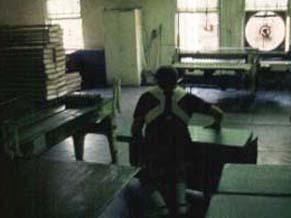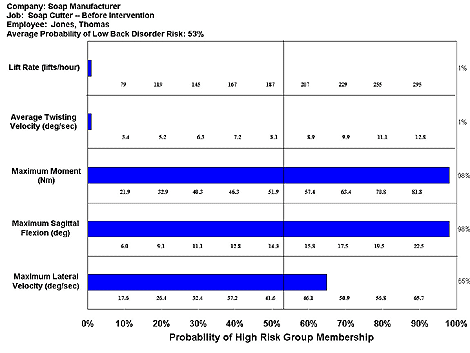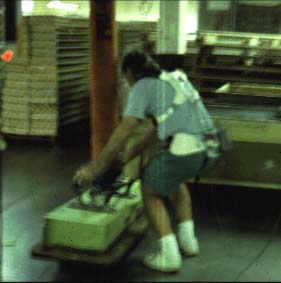Lumbar Motion Monitor Analysis of Soap Cutter Job
By W. Gary Allread, Ph.D., AEP, Program Director,
Institute for Ergonomics, Ohio State University, allread1@osu.edu
Soap Cutter Job - Before Change
The Soap Cutter job (see Figure 1) required employees to lift large slabs of soap from a wheeled cart and place them on a table, so that the slab could be cut into smaller soap bars. Depending on the height of the slab on the cart, some lifts were from near floor level. These slabs weighed approximately 60 pounds. The low-back incident rate, computed from the company's OSHA 200 logs, determined there were nearly 21 low-back strains on this job per 100 full-time employees per year.

Figure 1: Soap Cutter Job "Before"
An LMM analysis was conducted on employees who performed this job. The results (see Figure 2) found the job's overall risk ("probability of high risk group membership") to be 53%, in the moderate-to-high risk job category. The chart shows that the lifting frequency of the job was low, and there was also very little twisting velocity required by the spine to perform this job. However, the weight of the soap slabs created an extremely high external moment about the spine, and the low vertical height at which some slabs had to be lifted (near floor level) generated a very high sagittal flexion angle. The amount of lateral (side bending) velocity also was high.

Figure 2: LMM Risk Chart "Before"
Soap Cutter Job - After Change
The LBD Risk Model showed that the two areas where a job modification should focus, and result in the greatest potential to reduce the job's injury rate, was on the maximum moment and/or the sagittal flexion risk factors. The company decided to install an overhead vacuum lift (see Figure 3). The purpose of such a hoist is to maintain the weight of the soap slab, to reduce this burden on the employee.

Figure 3: Soap Cutter Job "After"
A subsequent LMM analysis, after the hoist has been in use for a number of months, found that the injury risk value was greatly reduced (see Figure 4), to an overall value of 27%. The vacuum lift significantly reduced the maximum moment factor, as well as the lateral velocity component. The lift rate and twisting velocity factors remained similar to those determined before the intervention. Of interest was that this hoist did not improve (i.e., reduce) the amount of sagittal flexion; it remained very high, even after this intervention occurred. In theory, injury risk could have been reduced further if a hoist had been designed that enabled employees to reach the soap slabs while in a more upright position. Regardless, yearly reviews of the company's records found that there have been no low-back strains in this job since the hoist was installed.

Figure 4: LMM Risk Chart "After"


